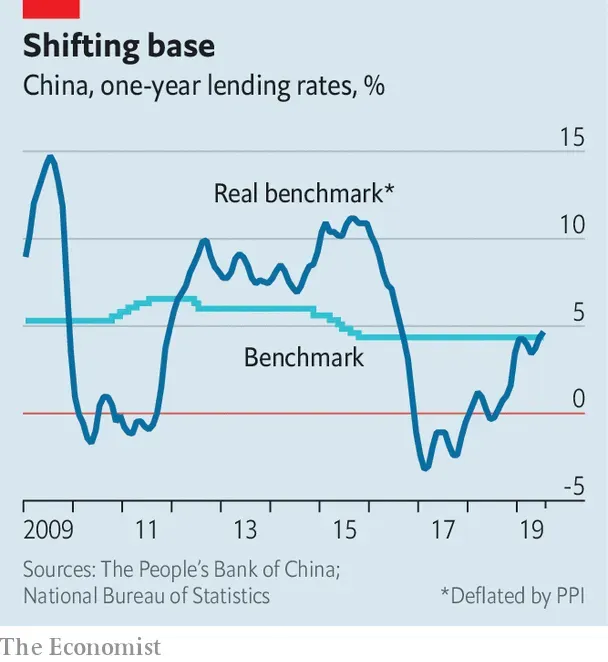This week, China interest rate reduction was announced by the People’s Bank of China, marking a significant step in the country’s strategy to revitalize its economy. With ongoing pressure from trade negotiations and economic growth concerns, the central bank decided to implement interest rate cuts to stimulate demand and encourage lending. The announcement included a cut in the seven-day reverse repurchase rate by 10 basis points, which is anticipated to affect the loan prime rate similarly. This action is part of broader financial measures aimed at ensuring liquidity in the market, with a notable decrease in the reserve requirement ratio releasing 1 trillion yuan. As China’s financial news unfolds, investors and analysts are closely watching how these adjustments may reshape economic landscapes and respond to the challenges of an evolving international trade environment.
In recent developments, the Chinese central bank has taken steps to ease monetary policy, evident through strategic interest rate reductions aimed at promoting economic stability. By cutting rates, they hope to enhance borrowing capabilities and mitigate the impact of existing trade tensions that have challenged the market. The People’s Bank of China has revealed plans to lower the essential rates that influence lending, thus encouraging financial flow and investment. Additionally, measures such as adjusting the reserve requirements for banks suggest a proactive approach to injecting capital into the economy. As discussions about trade continue against this backdrop, these financial moves could be pivotal in ensuring sustained growth in China’s dynamic market.
China Interest Rate Reduction: A Step Towards Economic Revival
On Wednesday, the People’s Bank of China announced a significant reduction in interest rates aimed at rejuvenating the nation’s economy amidst ongoing trade uncertainties. The central bank’s decision to cut the seven-day reverse repurchase rates by 10 basis points from 1.5% to 1.4% reflects a strategic move to enhance economic growth in China. This reduction will likely lead to a corresponding decrease in the loan prime rate, which is pivotal for borrowing costs across various sectors. By easing these rates, the government aims to stimulate investment and consumer spending, thereby injecting vigor into the financial landscape.
In addition to the rate cut, the People’s Bank of China has also decided to lower the reserve requirement ratio by 50 basis points, which will free up approximately 1 trillion yuan (around $138.6 billion) in liquidity. This influx of cash into the market is designed to support businesses and enhance overall economic activity. As interest rates decline, the ability for firms to obtain financing will improve, potentially leading to increased economic output and stability. This strategic maneuver is critical in the face of the ongoing uncertainties posed by trade negotiations and international economic conditions.
Impact of Interest Rate Cuts on Trade and Economic Growth in China
The recent interest rate cuts by the People’s Bank of China could have far-reaching implications for trade dynamics and economic growth in the nation. As the Chinese economy grapples with the fallout from intensified trade tensions with the United States, the central bank’s measures are intended to cushion the impact of these challenges. Lower interest rates typically foster a more favorable environment for businesses by reducing the cost of borrowing, encouraging firms to invest and expand. This development is particularly significant as China seeks to revitalize sectors that have been adversely affected by tariff hikes.
Moreover, as China and the U.S. prepare for their upcoming trade negotiations, the interest rate reductions may play a strategic role in enhancing China’s bargaining position. A more robust economic outlook, aided by favorable lending conditions, can strengthen China’s stance in discussions over tariffs and trade barriers. As officials from both countries engage in talks, the financial landscape, marked by reduced interest rates, will be pivotal in shaping the negotiations, ultimately impacting future economic growth and stability.
The Role of the People’s Bank of China in Economic Recovery
The People’s Bank of China is central to the nation’s efforts to foster economic recovery through monetary policy adjustments. By proactively implementing interest rate cuts, the central bank is responding to both domestic economic concerns and external trade pressures. The institution’s focus on liquidity provision through reduced reserve requirements highlights its commitment to supporting sustainable economic growth. In this regard, the People’s Bank of China serves not only as a regulator but also as a catalyst for stimulating the broader economy.
In conjunction with interest rate reductions, the People’s Bank of China’s collaboration with other financial regulatory authorities points to a unified approach in addressing economic challenges. These coordinated efforts enhance confidence among investors and businesses who are navigating the complex landscape of trade negotiations and market volatility. As the Chinese financial system adapts to these changes, it is vital for the central bank to remain agile in its policy responses to ensure that economic growth remains on a positive trajectory.
Understanding the Significance of Trade Negotiations Amid Rate Cuts
As China implements interest rate cuts, the significance of the upcoming trade negotiations with the United States cannot be overstated. These discussions, which are the first since tariffs escalated drastically, could determine the future of China’s trade relations and its overall economic health. With lower interest rates, China may have the opportunity to negotiate from a position of resilience, presenting a more stable economic front to U.S. trade representatives. This strategy could help mitigate the impacts of tariffs that have strained multiple sectors.
Furthermore, the trade talks are pivotal not only for resolving current disputes but also for fostering a more collaborative approach to future trade policies. By coupling efforts to reduce interest rates with a strong commitment to negotiation, China is signaling a willingness to adapt and innovate in the face of adversity. The outcome of these discussions could set the tone for bilateral relations moving forward, influencing investment flows and economic partnerships that are vital for growth.
Interest Rate Cuts: A Response to Global Economic Challenges
In the broader context of global economic challenges, China’s interest rate cuts represent a calculated response to various pressures from trade relations and international market conditions. With trade tensions looming and potential economic slowdowns on the horizon, policymakers are taking decisive actions to ensure economic stability. The decrease in interest rates serves as a crucial tool to combat not just local economic issues but also to navigate through the complexities of a shifting global trade environment.
As countries worldwide grapple with inflationary pressures from supply chain disruptions and geopolitical uncertainties, China’s proactive stance on interest rate reductions signals to the market its commitment to fostering an adaptive economic strategy. By aiming to boost domestic demand and investment, China seeks to maintain a competitive edge in the global marketplace. This approach is vital for sustaining economic momentum amidst external challenges that could hinder growth.
Liquidity Boost: The Impact of Cutting Reserve Requirements
The decision by the People’s Bank of China to cut reserve requirements by 50 basis points is a significant step towards enhancing liquidity in the financial system. Releasing approximately 1 trillion yuan into the market serves to bolster banks’ lending capabilities, ultimately injecting much-needed capital into the economy. This effect is amplified in a climate where businesses and consumers alike are feeling the tightening effects of ongoing trade conflicts and economic uncertainty.
In essence, this liquidity boost not only supports individual banks but also has a ripple effect throughout the economy. By enabling easier access to funds, businesses may be better positioned to invest and grow, stimulating job creation and consumer spending. As liquidity increases due to reduced reserve requirements, the potential for economic recovery becomes more tangible, reflecting the central bank’s commitment to fostering a resilient economic environment.
What the Future Holds: Economic Growth Predictions in China
The outlook for economic growth in China following the announced interest rate cuts remains cautiously optimistic. Analysts predict that if the current measures effectively stimulate lending and consumer spending, there could be a gradual revival in growth rates. However, the potential outcomes now heavily depend on the success of upcoming trade negotiations and their ability to alleviate the heightened tensions between China and the U.S. Sustained interaction and agreements could solidify market confidence, leading to favorable growth forecasts.
Nonetheless, it is critical to monitor how external factors, such as global demand shifts and geopolitical changes, may influence China’s economic trajectory. The interplay of these elements will significantly determine whether the recent monetary policy moves will lead to a rebound in economic performance or if further interventions will be required. The road to recovery may be complex, but informed actions based on current strategies will be essential to navigate through these turbulent times.
The Interplay of Monetary Policy and Trade Relations
Monetary policy and trade relations are intricately linked, especially in the context of China’s recent interest rate cuts. As the People’s Bank of China aims to stimulate domestic growth through lower borrowing costs, the implications of this policy are directly affected by the state of international trade partnerships. Trade relations, particularly those with economically pivotal nations like the United States, can significantly impact economic stability and growth prospects.
The effectiveness of interest rate cuts may hinge on the outcomes of trade negotiations, as tariff policies can either augment or mitigate the benefits derived from monetary easing. If negotiations yield positive results, businesses could see a revitalization of trade flows, further supporting economic expansion. Conversely, if tensions persist, the challenges posed by tariffs could undermine the effectiveness of even the most strategic monetary policies, indicating the importance of a cohesive approach to both fiscal and trade strategies.
Frequently Asked Questions
What is the significance of the recent China interest rate reduction by the People’s Bank of China?
The recent China interest rate reduction by the People’s Bank of China (PBOC) is significant as it aims to stimulate economic growth amid ongoing trade tensions. The cut in the seven-day reverse repurchase rate by 10 basis points aligns with efforts to lower the loan prime rate, facilitating cheaper borrowing costs for businesses and consumers.
How will the interest rate cuts affect economic growth in China?
The interest rate cuts are expected to positively impact economic growth in China by improving liquidity in the financial system. By reducing the reserve requirement ratio and releasing an estimated 1 trillion yuan, the PBOC is ensuring that banks have more funds to lend, which can boost spending and investments.
What role does the People’s Bank of China play in the interest rate cuts?
The People’s Bank of China plays a crucial role in the interest rate cuts as it is the nation’s central bank responsible for monetary policy. Governor Pan Gongsheng’s announcement reflects the PBOC’s commitment to addressing economic challenges and supports measures to enhance financial stability in the context of trade negotiations.
How do the recent interest rate cuts relate to trade negotiations between China and the U.S.?
The recent interest rate cuts are closely tied to the trade negotiations between China and the U.S. By reducing rates, China is attempting to bolster its economy in light of the uncertainties stemming from potential tariffs and trade barriers. This proactive measure seeks to mitigate the impact of trade tensions on economic growth.
What can we expect from future China financial news regarding interest rate policies?
Future China financial news may focus on additional interest rate policies and adjustments by the People’s Bank of China, particularly as trade negotiations with the U.S. unfold. Analysts will be closely monitoring the effects of these rate cuts on economic indicators and whether further measures will be implemented to support growth.
In what ways might the interest rate cuts influence market reactions?
Interest rate cuts by China’s central bank are likely to influence market reactions by boosting investor confidence and stabilizing financial markets. As borrowing costs decrease, this may lead to increased corporate investment and consumer spending, which could alleviate some market uncertainties stemming from the trade war.
| Key Point | Details |
|---|---|
| Interest Rate Cuts | The central bank reduced the seven-day reverse repurchase rate from 1.5% to 1.4%. |
| Loan Prime Rate Impact | This cut is expected to lower the loan prime rate by about 10 basis points. |
| Reserve Requirement Ratio | The reserve requirement ratio will be decreased by 50 basis points, releasing 1 trillion yuan. |
| Meeting with U.S. Officials | Chinese Vice Premier He Lifeng is scheduled to discuss tariff and trade issues with U.S. Treasury Secretary. |
| Trade Talks Significance | This is the first trade negotiation since significant tariff escalations between the U.S. and China. |
Summary
The China interest rate reduction is a significant move by the central bank aimed at stimulating economic growth and addressing trade-related concerns. With the reduction in key interest rates and the reserve requirement ratio, the People’s Bank of China is implementing measures that could inject liquidity into the market and positively influence borrowing costs. These actions, coupled with the upcoming trade discussions, signify a crucial attempt to navigate the complexities of trade relations and economic stability as China’s economy faces challenges in this evolving landscape.



